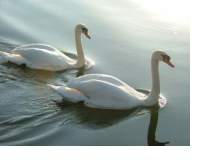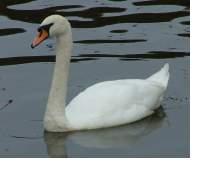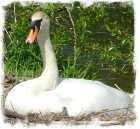| |
|
|
JULY - MUTE SWAN
The mute swan is irrevocably associated with William Shakespeare and the River Avon, so it is very appropriate to include it in our “Birds of Barford” series.
 Shakespeare himself was famously referred to as “Sweet Swan of Avon” by his contemporary Ben Johnson, a compliment marked today by The Swan Theatre - built next to the Royal Shakespeare Theatre in Stratford. Shakespeare himself was famously referred to as “Sweet Swan of Avon” by his contemporary Ben Johnson, a compliment marked today by The Swan Theatre - built next to the Royal Shakespeare Theatre in Stratford.
According to legend, Richard the Lionheart brought the first mute swans home from Cyprus after the Third Crusade, but it is likely that they were breeding wild in England long before this. They gradually became semi-domesticated because of their value as ornamental birds and as a luxury food.
For centuries, the Crown controlled the ownership of swans through royal swanherds and courts called “swanmotes”. It has been recognised as a “royal bird” since at least 1186, a status which was confirmed in law in the “Act of Swans” which came into force in 1482. Privately owned swans were pinioned to prevent them from flying away, and branded or nicked on the bill as a mark of ownership. In the reign of Elizabeth I in the 16th Century, 900 distinct swan markings were recognised. However, since that period, swans have been allowed to escape from captivity and are now wild breeding birds.
Today, the Crown retains the right to ownership of all unmarked mute swans in open water, but the Queen only exercises her ownership symbolically on certain stretches of the River Thames and its surrounding tributaries. In July each year, at the annual 'Swan-upping', the cygnets are still marked on the beak as either the property of the Crown or of the two privileged City of London companies, the Dyers and Vintners. More recently, a specific clause in The Wild Creatures and Forest Law Act (1971) safeguards the Queen's rights of swan ownership.
Identification:
 Mute swans are one of the most easily recognisable British birds. Mute swans are one of the most easily recognisable British birds.
The adult has pure white plumage, a long S-shaped neck and an orange bill with a black base.
They are Britain’s largest bird, and among the heaviest and largest flying birds in the world. Because of this, they require an expanse of water to take off and this difficulty in getting airborne contrasts starkly with their apparent peace and serenity when quietly paddling or feeding. Nevertheless, once in the air they make an impressive sight with graceful neck, steady head and, particularly at close quarters, whistling wing beats.
Population:
The UK population has increased continually since the mid-1980ís. A recent estimate (1997) suggests a population of 28,000 to 30,000 Mute Swans in Britain. Their distribution has changed little between the early 1970s and early 1990s but there have been wide variations in population over this period, with notable falls in harsh winters. Some birds stay in their territories all year, while others move short distances and form winter flocks. In cold weather, some birds arrive from Europe into eastern England.
The problem of lead poisoning on rivers like the Avon affected numbers dramatically in the 1960ís. Many Swans died because they were swallowing lead fishing weights with the grit they use to grind their food. This has now largely been solved by a ban on the sale of lead fishing weights. However, entanglement in fishing tackle can still be a problem for swans; discarded fishhooks and lengths of nylon fishing line can both result in a painful and unnecessary death.
Also relevant locally, the passage of boats can cause an increase in wash which damages bankside vegetation and disturbs riverside nesting and wintering birds. The breeding population of Mute Swan on the Warwickshire Avon has been noted to fall in those sections of the river subject to navigation. Similar RSPB studies of the River Great Ouse suggested that densities of breeding birds were lower on the navigated lower Ouse, compared to the unnavigated Ouse upstream of Bedford.
The Mute Swan appears on the UK Biodiversity Steering Group 'Long List of Globally Threatened/Declining Species' but is not on the RSPB list of 'Birds of Conservation Concern'. Because more than 20% of the European population is concentrated in the UK, the bird is placed on the Amber list.
Links :
RSPB, more about the mute swan
BTO, more about the mute swan
[Back to top]
|
|


